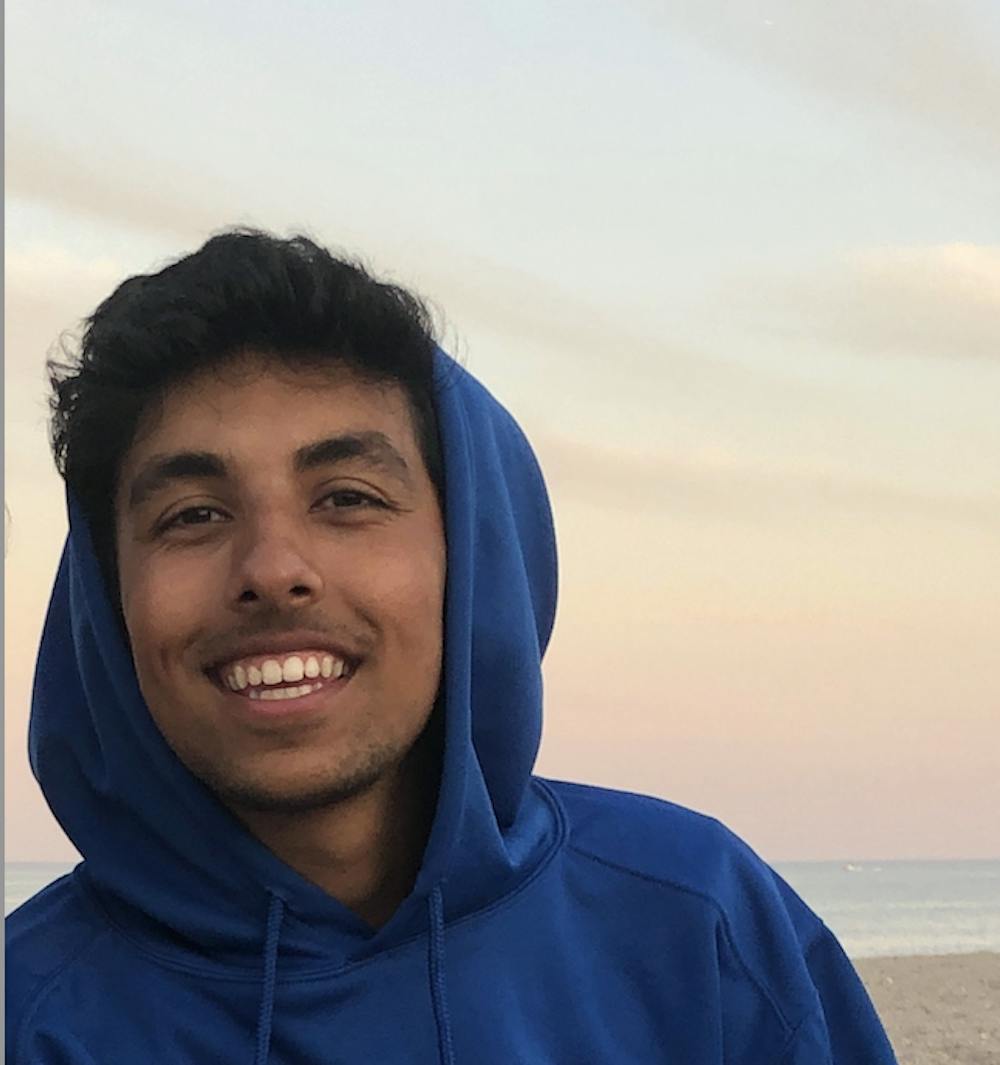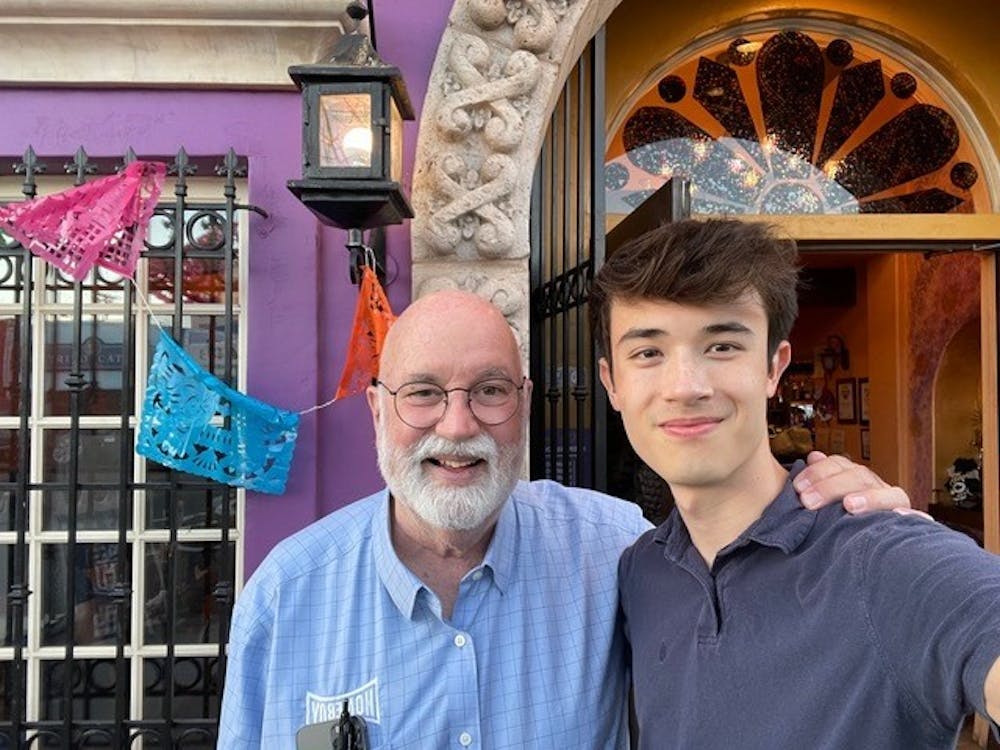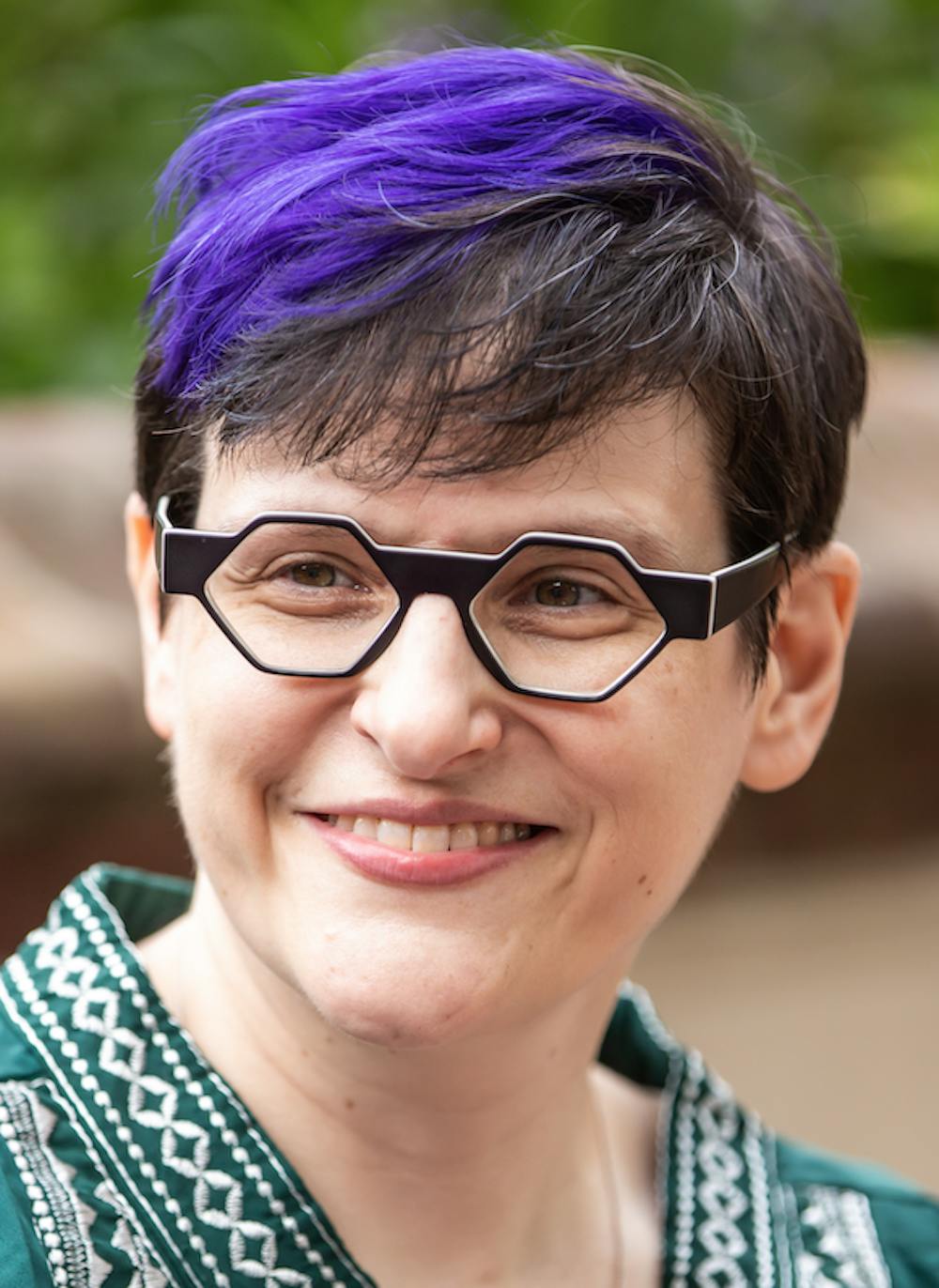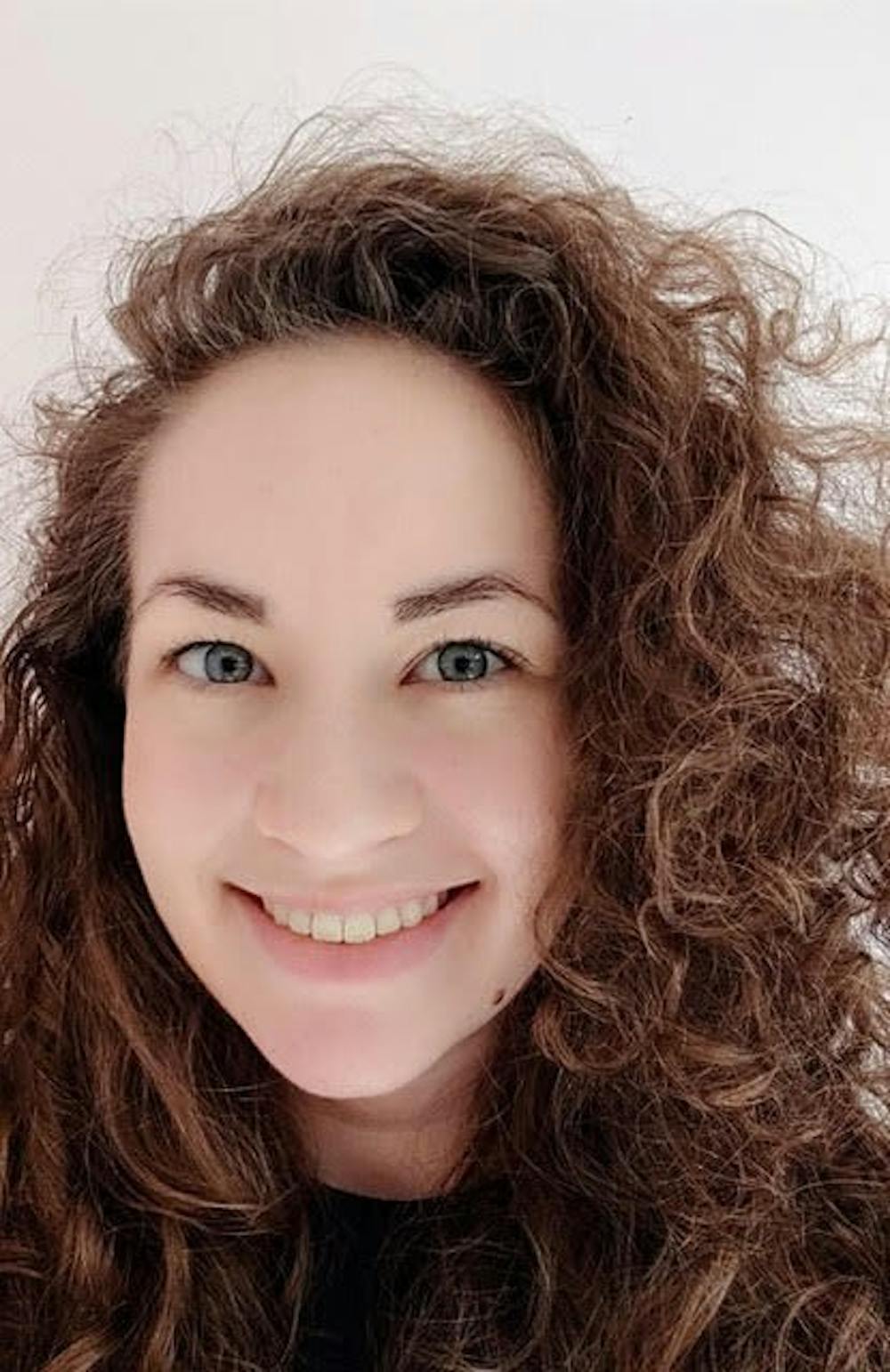Milan Chand (C '24) hid his identity for most of his life. He came out as gay after his senior year of high school, telling all of his friends and family on the same day in the summer of 2020—right in the middle of the pandemic.
“It wasn’t until I was in my isolation alone that I didn’t have to deal with anybody else’s opinion, and I was able to come out,” he says.
Milan wouldn’t call his hometown homophobic, but he says that “the culture of high school in general breeds homophobia.” His high school classmates speculated about him being gay behind his back, and he had to deny it when faced with those rumors.
“It was always this thing that people would make fun of me for. I would just have to deny and pretend like it was nothing. I would just heavily deny it and deny and deny.”
Fast forward two years: Now, Milan says he's found a welcoming community at Penn through a variety of organizations, including the Lambda Alliance, the LGBT Center, and the fraternity Phi Gamma Delta, commonly known as FIJI.
“I didn’t always feel comfortable with a big group of straight guys because there were always gay jokes being thrown around,” he says. “[But FIJI] allows you to still be open with all of them and still create those friendships, without the fear of your sexual identity getting in the way.”

“As soon as I got to college, it just kind of felt like a new me,” Milan says. “I finally felt like myself.”
Penn has been long commended as an LGBTQ–friendly college, consistently ranking among the top colleges for queer and transgender students for over the past decade. Campus Pride Index, a national listing of LGBTQ–friendly colleges and universities, gives Penn five out five stars. At Penn, many queer students have applauded administrative support for the LGBTQ community. The University’s LGBT Center is the physically largest and second oldest college LGBTQ center, preceded only by the University of Michigan’s.
These ideas that exist about Penn on paper do translate to lived experiences. Several LGBTQ students interviewed for this story feel completely at home at Penn. But this hasn’t been the case for every student: Others have experienced the exact opposite, encountering homophobia and toxicity—from cishet and queer students alike—that have pushed them away from Penn’s LGBTQ community. While the University is generally exceptional in its support for queer and transgender students compared to peer institutions, members of the community still wish for a more inclusive campus culture.
Martina* (C ’23) is a queer woman of color who has faced challenges trying to find her own space within Penn's LGBTQ culture. She came into college with the idea that she would be able to discover her place and her identity through Penn’s queer community. However, this hasn't been the case.
Martina, who is from South Texas, says her hometown is “violently conservative regarding everything gay.”
“It’s very quiet. People aren’t loud about it,” she adds, explaining that this was one of the reasons she wanted to go to college in a big city. Philadelphia has an extensive queer history and culture, including Washington Square West, which is known as the Gayborhood.
Dealing with such issues at home has affected how Martina expresses her sexuality at Penn.
“I’m not going to immediately become this out–and–proud and happy gay person,” she says.
Meanwhile, Alex (C '23)—another queer woman of color—is from Boulder, Colo., a left–leaning city. Still, she faced challenges regarding her sexuality in Boulder, which she says is “aggressively progressive, but in a damaging way because it’s all white liberals.”
Both Martina and Alex also feel that attitudes from progressive students at Penn—especially white progressives—have been implicitly homophobic and performative.
“I ran into a lot of people that were offhandedly homophobic,” Alex says. She explains that she used to joke around with the phrase “no homo,” and once used it in front of a straight friend, who replied, “Oh my God, yeah, definitely no homo.”
Another time, one of Alex’s straight friends went up to homophobic protestors and told them off. The friend looked back at Alex, smiled, and gave a thumbs up, signaling that she was supportive of Alex’s sexuality.
“Homophobia is homophobia, but when you try to mask it under progressivism, it bothers me a lot,” Martina says.
But even beyond interactions with straight students on campus, Martina and Alex say that the University’s queer community, a supposedly welcoming space, can be stifling. They both feel that they’ve been forced into certain labels or a certain archetype of an LGBTQ person by the queer community at Penn.
Martina says she struggled to fit in with other LGBTQ students because many of the people she’s encountered are upper–middle–class, part of the top 1%, or white.
“I [came to Penn] thinking, ‘There’s going to be a lot of gay people I’m going to relate to,’ and I didn’t relate to them at all, because these other identities were so conflicting,” she says. “Because they make up such a big portion of the out gay community here, it drove me away from the LGBT community.”

Oliver Kaplan (right) with his mentor, Father Greg Boyle, S.J., of Homeboy Industries. Photo courtesy of Oliver Kaplan
Martina and Alex have also encountered white queer students who claimed to understand various types of oppression because of their LGBTQ identity.
Alex explains that some interactions she’s had with white queer Penn students have gone along these lines: “Racism? Well, I’m gay, so I know exactly how that feels.”
“Gayness is their gateway to oppression,” Martina says.
When Alex came to Penn, she initially thought she was only attracted to women, but she slowly realized that she was attracted to men as well. Explaining this to her queer friends was met with a lot of biphobia, she says. Besides Martina, she hasn’t had many positive experiences with LGBTQ students at Penn.
“The LGBT community at this school likes to shove everybody into the same type of queer person,” Alex says. She explains that queer students have viewed her negatively because she never got involved with the LGBT Center, which just drove her away more.
“The LGBT students that I’ve interacted with, they’re so toxic, and they’re shaming,” she continues. “There’s nothing about Penn gays that make me want to be like, ‘I am proud to be gay at Penn.’”
On the other hand, other queer students have found a supportive and welcoming home in Penn’s LGBTQ community.
Oliver Kaplan (C '22) transferred to Penn after being outed during his sophomore year at Bates College. Now a senior, Oliver is deeply involved with Penn’s LGBT Center, and he participates in advocacy work around preventing nonconsensual outings.
“Penn was the first community where I was really welcomed for being part of the LGBT community,” he says. “Being able to reclaim a school environment in a more welcoming and accepting way was really important to me, and Penn has provided that.”
Overall, Oliver feels that the support for LGBTQ students at Penn is strong and inclusive of the intersectionality of each queer student’s identity.
“Every single identity group I belong to, there’s a queer group for [it],” he says. Some of these groups include J–Bagel (a group for queer Jewish students), Queer & Asian, and Queer Student Alliance.
Juliana Vollmer (C '24) came out as demiomnisexual/demibisexual during her senior spring of high school. She told a few of her teachers the week when her state went into lockdowns due to COVID–19.
“I’m still in my honeymoon period of being out,” Juliana says.
Juliana met one of her best friends and one of her roommates through the LGBT Center’s kikis, which are weekly casual chats for Penn’s queer students. She’s also utilized the Center’s community alongside other resources to work through mental health issues.
“I don’t feel like I have to hide anymore—my queerness or my mental health,” she says.
Penn’s queer community coalesces around the LGBT Center, which houses 28 student groups and programming for faculty, staff, and alumni. The Center’s reach is all–encompassing. It offers free printing, which allows queer or questioning students to explore the space without having to explain their identity, and the Peer Mentorship Program, which pairs younger queer students with older, out ones.
The LGBT Center participates in a lot of advocacy work, as one of the nine confidential resource centers on campus for Title IX issues. Staff are trained to help members of the Penn community who have faced discrimination based on their perceived or actual sexual orientation or gender identity.
The Center is also heavily involved in creating a safe educational environment for queer students. Staff members work with professors to make syllabi and classrooms more inclusive, as well as hold educational workshops on topics such as implicit bias.
According to Erin Cross, the director of the Center, all staff members there have an “open–door” policy—they leave their office doors open unless they’re in a meeting, essentially inviting students to talk to them about anything on their minds.

Cross also emphasizes that not all LGBTQ students have to be involved with the Center.
“Just because you’re part of our community doesn’t mean we expect to see you at the Center every day. Absolutely not. We want to see you when you feel comfortable coming,” she says. “We just want folks to know that they have a space where they belong.”
The Center provides a spectrum of resources to the queer community, but students from all backgrounds and experiences say the buck doesn’t stop there. Penn can do more to make the general undergraduate experience more inclusive, especially when it comes to educating students on implicit and explicit forms of homophobia and transphobia.
Institutionally, both Martina and Alex praise Penn’s efforts in supporting the community. Martina specifically cites the LGBT Center, availability of LGBTQ health services, and LGBTQ–centric mental health care through CAPS. They both say that 90% of the problems with queer culture on campus stem from the people—not the administration.
Juliana says that she would like to see education on LGBTQ issues go beyond students that come to the LGBT Center, as these students are usually either queer or allies.
“There’s this belief that homophobia is eradicated on campus,” Juliana says, which has led to a lapse in understanding between the queer community and straight, cishet students.
She suggests that this education could be included in the Thrive At Penn (TAP) segment of New Student Orientation that incoming students are required to participate in. She even proposes that the LGBT Center could work with other cultural groups on campus to create a section in the TAP modules that informs students about the issues marginalized groups face at Penn.

Photo courtesy of Juliana Vollmer
Other than educational reforms, institutional changes can help create space for a more inclusive LGBTQ culture. For instance, Cross says that the LGBT Center badly needs a third staff member. She also strongly emphasizes the need for all–gender restrooms in University buildings. Students who don’t identify within the gender binary often have to go to other buildings—or not use the restroom at all—during class because there's no all–gender bathroom in the building. This also poses an issue for staff or faculty who need those restrooms.
“There are folks who want and need gendered restrooms. We totally support that, 110%. But there [need] to be bathrooms for folks of all identities,” she says.
Ultimately, even Penn, a university lauded for its LGBTQ spaces and programming, isn’t exempt from homophobia, transphobia, or discrimination. A positive experience for one queer student doesn’t necessarily guarantee a positive experience for others, leaving a trail of cultural changes this campus needs to make to ensure the safety and well–being of all LGBTQ individuals at Penn.
*Indicates a name has been changed for anonymity.
